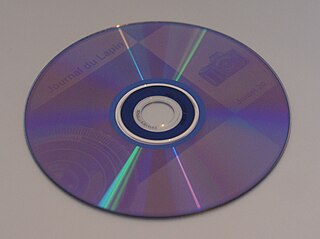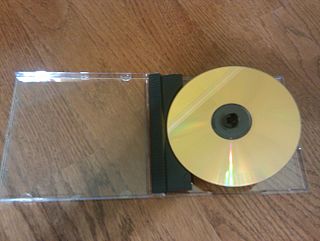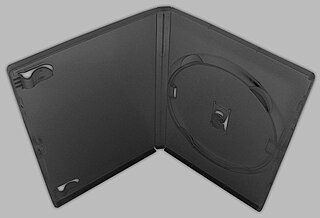 W
WCompact disc (CD) is a digital optical disc data storage format that was co-developed by Philips and Sony and released in 1982. The format was originally developed to store and play only digital audio recordings (CD-DA) but was later adapted for storage of data (CD-ROM). Several other formats were further derived from these, including write-once audio and data storage (CD-R), rewritable media (CD-RW), Video CD (VCD), Super Video CD (SVCD), Photo CD, PictureCD, Compact Disc-Interactive (CD-i), and Enhanced Music CD. The first commercially available audio CD player, the Sony CDP-101, was released October 1982 in Japan.
 W
WCompact disc (CD) is a digital optical disc data storage format that was co-developed by Philips and Sony and released in 1982. The format was originally developed to store and play only digital audio recordings (CD-DA) but was later adapted for storage of data (CD-ROM). Several other formats were further derived from these, including write-once audio and data storage (CD-R), rewritable media (CD-RW), Video CD (VCD), Super Video CD (SVCD), Photo CD, PictureCD, Compact Disc-Interactive (CD-i), and Enhanced Music CD. The first commercially available audio CD player, the Sony CDP-101, was released October 1982 in Japan.
 W
WThe DTS Music Disc, DTS Audio CD or 5.1 Music Disc is an audio Compact Disc that contains music in one of various possible surround sound configurations. The specification permits discrete channel configurations from 2.0 to 6.1, although 5.1 is the most common. Physically, a DTS Music Disc conforms to the Red Book standard; however a DTS bitstream, based on the Coherent Acoustics compression algorithm, is actually encapsulated in each PCM audio track. This configuration permits any non-DTS enabled player to output multi-channel audio when connected to an external DTS-compliant processor via a digital interface like S/PDIF or HDMI, provided that the player does not modify the bitstream internally.
 W
WA bootable business card (BBC) is a CD-ROM that has been cut, pressed, or molded to the size and shape of a business card. Alternative names for this form factor include "credit card," "hockey rink," and "wallet-size". The cards are designed to hold about 50 MB. The CD-ROM business cards are generally used for commercial product demos, are mailed to prospective customers, and are given away at trade shows.
 W
WCD Video is a format of optical media disc that was introduced in 1987 that combines the technologies of standard compact disc and LaserDisc. CD-V discs are the same size as a standard 12-cm audio CD, and contain up to 20 minutes' worth of CD Audio that can be played on any audio CD player. It also contains up to 5 minutes of LaserDisc video information with digital CD-quality sound, which can be played back on a newer LaserDisc player capable of playing CD-V discs or CD-V-only players.
 W
WThe Compact Disc-Interactive is a digital optical disc data storage format that was mostly developed and marketed by Dutch company Philips. It was created as an extension of CDDA and CD-ROM and specified in the Green Book, co-developed by Philips and Sony, to combine audio, text and graphics. The two companies initially expected to impact the education/training, point of sale, and home entertainment industries, but CD-i eventually became best known for its video games.
 W
WCD-R is a digital optical disc storage format. A CD-R disc is a compact disc that can be written once and read arbitrarily many times.
 W
WA CD-ROM is a pre-pressed optical compact disc that contains data. Computers can read—but not write to or erase—CD-ROMs.
 W
WCD-RW is a digital optical disc storage format introduced in 1997. A CD-RW compact disc (CD-RWs) can be written, read, erased, and re-written.
 W
WCD-Text is an extension of the Red Book Compact Disc specifications standard for audio CDs. It allows for storage of additional information on a standards-compliant audio CD.
 W
WCD+G is an extension of the compact disc standard that can present low-resolution graphics alongside the audio data on the disc when played on a compatible device. CD+G discs are often used for karaoke machines, which use this functionality to present on-screen lyrics for the song contained on the disc. The CD+G specifications were published by Philips and Sony in an updated revision of the Red Book specifications.
 W
WCDVU+ was a type of enhanced CD released by Walt Disney Company in 2007. It was essentially a revamped version of the Compact Disc (CD), and includes multimedia "Extras" on the disc. New features such as "digital magazine extras" like band photos, interviews, lyrics, and exclusive photos could be accessed by inserting the disc into a computer.
 W
WCompact disc bronzing, or CD bronzing, is a specific variant of disc rot, a type of corrosion that affects the reflective layer of compact discs and renders them unreadable over time. The phenomenon was first reported by John McKelvey in the September/October 1994 issue of American Record Guide.
 W
WA compressed audio optical disc, MP3 CD, or MP3 CD-ROM or MP3 DVD is an optical disc that contains digital audio in the MP3 file format. Discs are written in the "Yellow Book" standard data format, as opposed to the Red Book standard audio format.
 W
WIn the recording industry, a cut-out refers to a deeply discounted or remaindered copy of an LP, 45 RPM single, cassette tape, Compact Disc, or other item.
 W
WDiscT@2 is a method of writing text and graphics to the data side of a CD-R or DVD disc first introduced by Yamaha in 2002. While often compared with the later LabelFlash and LightScribe technologies, which also offered users consumer-grade computerized disc labeling, DiscT@2 is different in that it required no proprietary media and wrote the graphics to the data side of the disc.
 W
WExtended Resolution Compact Disc (XRCD) is a mastering and manufacture process patented by JVC for producing Red Book compact discs. It was first introduced in 1995.
 W
WThe Sega Genesis, known as the Mega Drive outside North America, is a 16-bit fourth-generation home video game console developed and sold by Sega. The Genesis is Sega's third console and the successor to the Master System. Sega released it as the Mega Drive in Japan in 1988, and later as the Genesis in North America in 1989. In 1990, it was distributed as the Mega Drive by Virgin Mastertronic in Europe, Ozisoft in Australasia, and Tec Toy in Brazil. In South Korea, it was distributed by Samsung as the Super Gam*Boy and later the Super Aladdin Boy.
 W
WA gold compact disc is one in which gold is used in place of the super pure aluminium commonly used as the reflective coating on ordinary CDs or silver on ordinary CD-Rs
 W
WISO 9660 is a file system for optical disc media. Being sold by the International Organization for Standardization (ISO) the file system is considered an international technical standard. Since the specification is available for anybody to purchase, implementations have been written for many operating systems.
 W
WA keep case or poly-box is a type of packaging, most commonly used with DVDs.
 W
WLabelflash is a technology which allows users to burn custom designs or images onto proprietary DVD media first announced in October 2005 as a collaboration between Yamaha and Fujifilm. While Yamaha developed the optical drives, Fujifilm manufactured the proprietary Labelflash optical discs. NEC manufactured the first Labelflash compatible drive, the ND4551, which was released in December 2005.
 W
WLightScribe is an optical disc recording technology that was created by the Hewlett-Packard Company. It uses specially coated recordable CD and DVD media to produce laser-etched labels with text or graphics, as opposed to stick-on labels and printable discs. Although HP is no longer developing the technology, it is still maintained and supported by a number of independent enthusiasts.
 W
WA longbox is a form of exterior paperboard packaging for musical compact discs in widespread use in the 1980s and early 1990s in North America.
 W
WCompact disc manufacturing is the process by which commercial compact discs (CDs) are replicated in mass quantities using a master version created from a source recording. This may be either in audio form (CD-Audio) or data form (CD-ROM). This process is used in the mastering of read-only compact discs. DVDs and Blu-rays use similar methods.
 W
WMini CDs, or pocket CDs, are CDs with a smaller diameter and one-third the storage capacity of a standard 120 mm disc.
 W
WMovieCD is a format for digital video storage and consumer home video playback released in 1996 by Sirius Publishing, and was rendered obsolete by the wider distribution of DVD. It used a video codec called MotionPixels, marketed by MotionPixels, Inc., a subsidiary of Sirius Publishing. It was used in many third-party video games from the mid to late-1990s, and during the same time on Sirius's MovieCDs that it had been originally developed for, enjoying an international distribution in both forms.
 W
WIn computing and optical disc recording technologies, an optical disc (OD) is a flat, usually circular disc that encodes binary data (bits) in the form of pits and lands on a special material on one of its flat surfaces.
 W
WOptical disc authoring requires a number of different optical disc recorder technologies working in tandem, from the optical disc media to the firmware to the control electronics of the optical disc drive. This article discusses some of the more important technologies.
 W
WPhoto CD is a system designed by Kodak for digitizing and saving photos onto a CD. Launched in 1991, the discs were designed to hold nearly 100 high quality images, scanned prints and slides using special proprietary encoding. Photo CDs are defined in the Beige Book and conform to the CD-ROM XA and CD-i Bridge specifications as well. They were intended to play on CD-i players, Photo CD players, and any computer with a suitable software.
 W
WA CD player is an electronic device that plays audio compact discs, which are a digital optical disc data storage format. CD players were first sold to consumers in 1982. CDs typically contain recordings of audio material such as music or audiobooks. CD players may be part of home stereo systems, car audio systems, personal computers, or portable CD players such as CD boomboxes. Most CD players produce an output signal via a headphone jack or RCA jacks. To use a CD player in a home stereo system, the user connects an RCA cable from the RCA jacks to a hi-fi and loudspeakers for listening to music. To listen to music using a CD player with a headphone output jack, the user plugs headphones or earphones into the headphone jack.
 W
WA portable CD player is a portable audio player used to play compact discs. The first audio player released was the Discman D-50 by Sony.
 W
WApple PowerCD is a CD player sold by Apple Computer in 1993 and discontinued several years later. It was a re-badged Philips-designed product which was sold in addition to Apple's speakers and also included a remote control. The PowerCD was capable of reading Kodak photo CDs, data CDs and audio CDs. It can connect to Apple Macintosh personal computers through SCSI and also to stereo systems and televisions.
 W
WPrinco Corp. v. ITC, 616 F.3d 1318 was a 2010 decision of the United States Court of Appeals for the Federal Circuit, that sought to narrow the defense of patent misuse to claims for patent infringement. Princo held that a party asserting the defense of patent misuse, absent a case of so-called per se misuse, must prove both "leveraging" of the patent being enforced against it and a substantial anticompetitive effect outside the legitimate scope of that patent right. In so ruling, the court emphasized that the misuse alleged must involve the patent in suit, not another patent.
 W
WThe Rainbow Books is a collection of CD format specifications.
 W
WA shaped Compact Disc is a non-circular compact disc. Examples include business card CDs, CDs in the shape of a star, a map of a country, interview material and more. These disks are usually made for marketing purposes and are properly read by most CD-ROM drives. There are many companies that sell CDs with custom shapes.
 W
WA snap case is a type of optical disc packaging, used for DVDs and CDs, also known as a paperback case, Ivy Hill Snapper, "snapper case", or FLP case.
 W
WThe Sony CDP-101 is the world's first commercially released compact disc player. The system was launched in Japan on October 1, 1982 at a list price of 168,000 yen.
 W
WThe SPARS code is a three-position alphabetic classification system developed in the early 1980s by the Society of Professional Audio Recording Services (SPARS) for commercial compact disc releases to denote aspects of the sound recording and reproduction process, distinguishing between the use of analog equipment and digital equipment. The code's three positions refer to recording, mixing, and mastering respectively. The first two positions may be coded either "A" for analog or "D" for digital; the third position (mastering) is always "D" on digital CDs. The scheme was not originally intended to be limited to use on digital packaged media: it was also available for use in conjunction with analog releases such as vinyl or cassette, but this was never done in practice.
 W
WSuper Audio CD (SACD) is a read-only optical disc format for audio storage, introduced in 1999. It was developed jointly by Sony and Philips Electronics, and intended to be the successor to the Compact Disc (CD) format.
 W
WVideo CD is a home video format and the first format for distributing films on standard 120 mm (4.7 in) optical discs. The format was widely adopted in Southeast Asia and the Middle East, superseding the VHS and Betamax systems in the regions until DVD-Video finally became affordable in the late 2000s.
 W
WThe VideoNow is a portable video player produced by Hasbro and released by their subsidiary Tiger Electronics in 2003. The systems use discs called PVDs, which can store about 30 minutes of video, the length of an average TV show with commercials, so each PVD contains only one episode, with trailers at the end to use the leftover time on most PVDs, including Nickelodeon PVDs. Video data is stored on the left audio channel with audio on the right channel, thus making it impossible to achieve stereo sound on the system, which only plays in black and white. The video plays at about 15 frames per second. Most of the shows were from Nickelodeon, such as SpongeBob SquarePants and The Fairly OddParents, and later they released shows from Cartoon Network, such as Ed, Edd n Eddy and Dexter's Laboratory. A small amount of movies were also released on the system, but due to the limited space on a PVD, said movies would have to be released on at least three discs, depending on the length of said film.